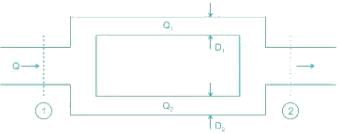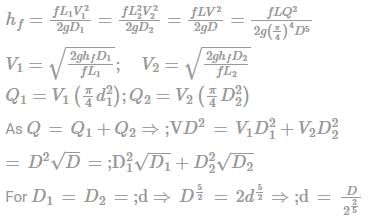SSC Exam > SSC Questions > To replace a pipe of diameter D by n paralle...
Start Learning for Free
To replace a pipe of diameter D by n parallel pipes of diameter d, the formula used is
- a)d = D/n
- b)d = D/n1/2
- c)d = D/n3/2
- d)d = D/n2/5
Correct answer is option 'D'. Can you explain this answer?
Verified Answer
To replace a pipe of diameter D by n parallel pipes of diameter d, th...
The main pipeline divides into two or more parallel pipes, which again join together downstream.

View all questions of this test

Q = Q1 + Q2

For n parallel pipes of diameter d, d = D/n2/5
Most Upvoted Answer
To replace a pipe of diameter D by n parallel pipes of diameter d, th...
The main pipeline divides into two or more parallel pipes, which again join together downstream.


Q = Q1 + Q2

For n parallel pipes of diameter d, d = D/n2/5
Free Test
FREE
| Start Free Test |
Community Answer
To replace a pipe of diameter D by n parallel pipes of diameter d, th...
Replacing a Pipe with Parallel Pipes
To replace a pipe of diameter D with n parallel pipes of diameter d, the formula used is:
d = D/n^0.4
Explanation:
- The formula for the hydraulic diameter of a pipe is given by:
Dh = 4A/P
where Dh is the hydraulic diameter, A is the cross-sectional area of the pipe, and P is the wetted perimeter of the pipe. For a circular pipe, the hydraulic diameter is simply the diameter of the pipe.
- The formula for the flow rate (Q) through a pipe is given by:
Q = (π/4)D^2v
where v is the velocity of the fluid in the pipe.
- If we replace the single pipe of diameter D with n parallel pipes of diameter d, the total cross-sectional area of the parallel pipes is n times the cross-sectional area of the single pipe. Therefore, the velocity of the fluid in the parallel pipes will be n times less than the velocity in the single pipe to maintain the same flow rate (Q).
- Using the continuity equation, we can relate the velocity of the fluid to the cross-sectional area of the pipe:
Q = Av
where A is the cross-sectional area of the pipe.
- Combining the above equations, we get:
(π/4)D^2v = n(π/4)d^2(v/n)
Simplifying this equation, we get:
d = D/n^0.4
Therefore, the formula used to replace a pipe of diameter D with n parallel pipes of diameter d is:
d = D/n^0.4
To replace a pipe of diameter D with n parallel pipes of diameter d, the formula used is:
d = D/n^0.4
Explanation:
- The formula for the hydraulic diameter of a pipe is given by:
Dh = 4A/P
where Dh is the hydraulic diameter, A is the cross-sectional area of the pipe, and P is the wetted perimeter of the pipe. For a circular pipe, the hydraulic diameter is simply the diameter of the pipe.
- The formula for the flow rate (Q) through a pipe is given by:
Q = (π/4)D^2v
where v is the velocity of the fluid in the pipe.
- If we replace the single pipe of diameter D with n parallel pipes of diameter d, the total cross-sectional area of the parallel pipes is n times the cross-sectional area of the single pipe. Therefore, the velocity of the fluid in the parallel pipes will be n times less than the velocity in the single pipe to maintain the same flow rate (Q).
- Using the continuity equation, we can relate the velocity of the fluid to the cross-sectional area of the pipe:
Q = Av
where A is the cross-sectional area of the pipe.
- Combining the above equations, we get:
(π/4)D^2v = n(π/4)d^2(v/n)
Simplifying this equation, we get:
d = D/n^0.4
Therefore, the formula used to replace a pipe of diameter D with n parallel pipes of diameter d is:
d = D/n^0.4

|
Explore Courses for SSC exam
|

|
Question Description
To replace a pipe of diameter D by n parallel pipes of diameter d, the formula used isa)d = D/nb)d = D/n1/2c)d = D/n3/2d)d = D/n2/5Correct answer is option 'D'. Can you explain this answer? for SSC 2025 is part of SSC preparation. The Question and answers have been prepared according to the SSC exam syllabus. Information about To replace a pipe of diameter D by n parallel pipes of diameter d, the formula used isa)d = D/nb)d = D/n1/2c)d = D/n3/2d)d = D/n2/5Correct answer is option 'D'. Can you explain this answer? covers all topics & solutions for SSC 2025 Exam. Find important definitions, questions, meanings, examples, exercises and tests below for To replace a pipe of diameter D by n parallel pipes of diameter d, the formula used isa)d = D/nb)d = D/n1/2c)d = D/n3/2d)d = D/n2/5Correct answer is option 'D'. Can you explain this answer?.
To replace a pipe of diameter D by n parallel pipes of diameter d, the formula used isa)d = D/nb)d = D/n1/2c)d = D/n3/2d)d = D/n2/5Correct answer is option 'D'. Can you explain this answer? for SSC 2025 is part of SSC preparation. The Question and answers have been prepared according to the SSC exam syllabus. Information about To replace a pipe of diameter D by n parallel pipes of diameter d, the formula used isa)d = D/nb)d = D/n1/2c)d = D/n3/2d)d = D/n2/5Correct answer is option 'D'. Can you explain this answer? covers all topics & solutions for SSC 2025 Exam. Find important definitions, questions, meanings, examples, exercises and tests below for To replace a pipe of diameter D by n parallel pipes of diameter d, the formula used isa)d = D/nb)d = D/n1/2c)d = D/n3/2d)d = D/n2/5Correct answer is option 'D'. Can you explain this answer?.
Solutions for To replace a pipe of diameter D by n parallel pipes of diameter d, the formula used isa)d = D/nb)d = D/n1/2c)d = D/n3/2d)d = D/n2/5Correct answer is option 'D'. Can you explain this answer? in English & in Hindi are available as part of our courses for SSC.
Download more important topics, notes, lectures and mock test series for SSC Exam by signing up for free.
Here you can find the meaning of To replace a pipe of diameter D by n parallel pipes of diameter d, the formula used isa)d = D/nb)d = D/n1/2c)d = D/n3/2d)d = D/n2/5Correct answer is option 'D'. Can you explain this answer? defined & explained in the simplest way possible. Besides giving the explanation of
To replace a pipe of diameter D by n parallel pipes of diameter d, the formula used isa)d = D/nb)d = D/n1/2c)d = D/n3/2d)d = D/n2/5Correct answer is option 'D'. Can you explain this answer?, a detailed solution for To replace a pipe of diameter D by n parallel pipes of diameter d, the formula used isa)d = D/nb)d = D/n1/2c)d = D/n3/2d)d = D/n2/5Correct answer is option 'D'. Can you explain this answer? has been provided alongside types of To replace a pipe of diameter D by n parallel pipes of diameter d, the formula used isa)d = D/nb)d = D/n1/2c)d = D/n3/2d)d = D/n2/5Correct answer is option 'D'. Can you explain this answer? theory, EduRev gives you an
ample number of questions to practice To replace a pipe of diameter D by n parallel pipes of diameter d, the formula used isa)d = D/nb)d = D/n1/2c)d = D/n3/2d)d = D/n2/5Correct answer is option 'D'. Can you explain this answer? tests, examples and also practice SSC tests.

|
Explore Courses for SSC exam
|

|
Signup for Free!
Signup to see your scores go up within 7 days! Learn & Practice with 1000+ FREE Notes, Videos & Tests.


















